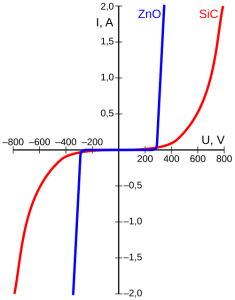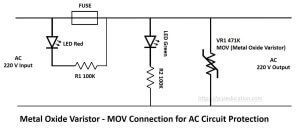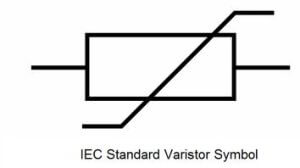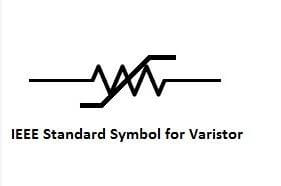Table of Contents
Varistor or Pressure-Sensitive Resistor
Introduction
The varistor symbol is a key element in circuit diagrams, representing a vital component for protecting electronic devices from voltage surges. However, what exactly is a varistor, and how does it function? This article delves into the varistor’s symbol, characteristics, types, working principles, and testing methods, providing a comprehensive guide to this essential electronic component.
Definition of Varistor
A varistor is a device with a nonlinear voltage-current characteristic. It is primarily used to clamp voltage when a circuit is subjected to overvoltage, absorb excess current, and protect sensitive equipment. Common varistors are made of metal oxides (such as MOV, metal oxide varistors) and are widely used in surge protection applications in power supplies, communication equipment, and consumer electronics.
If you are looking for high-quality varistors for your project or production needs, browse varistors category here to find a wide selection of reliable products with detailed specifications and datasheets, ready for immediate purchase.
Varistor Symbol
Symbols may vary slightly depending on the standard, but the core design is to highlight their voltage sensitivity.
| IEC standard symbols, identical to those for thermistors | |
| IEEE standard symbols |
Characteristics of Varistor
- Nonlinear Voltage-Current characteristics
Under normal operating voltage conditions, the varistor exhibits extremely high resistance, reaching megohm levels, equivalent to an insulating state.
When the voltage exceeds the threshold voltage (Vₙ), the resistance drops sharply, the current rises sharply, and significant conductivity is exhibited, forming a conductive path. At this point, the varistor clamps the voltage by diverting the large current.

- Rapid Response (Nanosecond Level)
The core material of a varistor (e.g., ZnO) undergoes a rapid avalanche effect under high voltage, causing a sudden drop in grain boundary resistance and forming a low-resistance path. This process is a physical characteristic and does not require a trigger circuit, resulting in no delay.
Therefore, varistors respond extremely quickly to transient voltages (within 5–25 ns), far faster than fuses (millisecond level) or gas discharge tubes (microsecond level), and possess exceptional transient suppression capabilities, effectively mitigating high-frequency, high-voltage transient disturbances such as lightning strikes and electrostatic discharge (ESD).
- Voltage Clamping
When the voltage applied across the varistor exceeds its threshold voltage, the varistor’s resistance drops sharply, thereby limiting the voltage to a safe range and preventing damage to downstream circuits.
Types of Varistor
The two most important types of pressure-sensitive resistors are:
- Metal Oxide Varistors (MOV)
It is primarily composed of zinc oxide (ZnO) with other metal oxides doped in, sintered into a polycrystalline semiconductor ceramic, and exhibits nonlinear voltage-current characteristics. It can absorb energy up to several thousand joules, has a response time of nanoseconds, is cost-effective, and is widely used in AC power surge protection. However, its performance degrades gradually after multiple surges and may fail due to overloading, requiring the use of a fuse in conjunction.
- Silicon Carbide Varistor (SiC Varistor)
Before MOVs entered the market, this was the most common type of varistor, made from silicon carbide (SiC). It offers excellent stability and high-temperature resistance, making it suitable for high-voltage, high-energy applications; however, its nonlinear characteristics are less pronounced than those of MOVs (higher leakage current), and its response speed in the microsecond range cannot match that of MOVs.
What Does a Varistor Do?
Varistors perform multiple critical functions in electronic systems:
- Transient voltage suppression: Their primary role is to suppress voltage spikes that could damage sensitive electronic components.
- Lightning protection: Especially in power distribution and telecommunications equipment, varistors prevent surges caused by lightning strikes.
- Switching surge suppression: They prevent high-voltage transients caused by switching operations in power systems.
- Electrostatic discharge (ESD) protection: Varistors help prevent damage caused by electrostatic discharge.
- Voltage regulation: In some special applications, varistors help maintain voltage within acceptable limits.
The primary function of varistors is to protect circuits from transient voltages. Due to their operating principle, as described above, varistors act as switches. Only when the voltage exceeds its threshold does the switch close, causing a surge in current flowing through it. This has minimal impact on other circuits, thereby reducing the effects of overvoltage on subsequent sensitive circuits. The protective function of varistors can be reused and can also be made into disposable protective devices similar to current fuses.
The protective function of varistors has been widely applied. For example, power circuits in home color TVs use varistors to achieve overvoltage protection. When the voltage exceeds the threshold, the varistor exhibits its clamping characteristic. Excessive voltage is reduced to ensure that subsequent circuits operate within a safe voltage range.
Due to its voltage-current characteristic similar to that of a semiconductor Zener diode, the varistor also has multiple functions of a circuit component. For example, it can be used as a voltage fluctuation detection element, a DC voltage shift element, a fluorescent startup element, and a voltage balancing element.
How Does a Varistor Work?
- Normal operating mode
When the applied voltage remains below the threshold voltage of the varistor, it exhibits extremely high resistance (typically in the megohm range), allowing only negligible leakage current to flow. In this state, the varistor effectively acts as an open circuit.
- Protection mode
When the voltage exceeds the threshold, the resistor‘s resistance drops sharply (by several orders of magnitude), enabling it to conduct a large current. This creates a low-impedance path that diverts surge currents away from the protected components.
How to Test a Varistor?
- Preparations before measuring pressure-sensitive resistors
Connect the two test leads of the multimeter (regardless of polarity) to the two terminals of the resistor to measure the actual resistance value. To improve measurement accuracy, select an appropriate range based on the rated value of the resistor being measured. Since there is a linear relationship between the ohm scale and the resistance value, the middle portion of the scale has higher precision. Therefore, the pointer reading should be as close as possible to the middle of the scale, i.e., within the 20% to 80% range of the full scale.
- How to measure the quality of a pressure-sensitive resistor?
To determine the characteristics of a varistor, a power supply with a wide adjustable voltage range and sound current limiting capability is typically required. During measurement, connect a high-precision voltmeter in parallel across the varistor. Connect the adjustable power supply leads to the two terminals of the varistor.
The voltmeter displays the power supply voltage. Slowly adjust the voltage; when the voltage reaches a specific value, it will suddenly drop. The voltage value at the last moment before the drop is the protection value of the varistor.
Under continuous voltage, the resistance value of the varistor can change from megohms (MΩ) to milliohms (mΩ). When the voltage is low, the varistor operates in the leakage current region, exhibiting high resistance and low leakage current; when the voltage enters the nonlinear region, the current varies over a wide range while the voltage changes little, demonstrating excellent voltage limiting characteristics; when the voltage increases further, the varistor enters the saturation region, exhibiting very low linear resistance. Due to the high current, the varistor may overheat and burn out, or even explode.
Circuit Diagram – Varistor connection for AC circuit protection

This circuit is for educational purposes only



